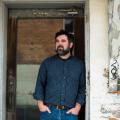Growing up in an Irish Catholic town in central New York, I learned early that church would be mysterious, complicated, and painful. The first two sacraments of initiation — baptism and confirmation — went well enough, especially since I had no recollection of the former. But the third, Eucharist, would prove more challenging.
We were maybe 7 years old, all dressed up for First Communion. Grandparents, aunts and uncles, and others came to the service to witness us crossing this threshold. We boys wore button-down shirts with ties while the girls wore white dresses. I have one picture from that day. I’m squinting in the sun outside our church, called, appropriately, Blessed Sacrament. There are decorative fishes and loaves on the front of the building. (The walls inside feature memorable depictions of the Stations of the Cross.)
In the picture I look naïve — happy, even. I look like a child who has not apprehended the complex relationship between the bread and wine, and the cross of Calvary.
I remember standing in line to the altar, watching what the others did so I wouldn’t screw it up. And I didn’t. I took my First Communion.
Then I had a sudden sensory reaction, common among people with autism. As I walked back to the pew, I finally tasted the thing, the host, the “bread of life.” While they had taught me that it was consecrated and in fact transubstantiated — that it had become the actual body of actual Christ — no one mentioned that it would taste like Styrofoam. The omission seemed cruel. Among the more peculiar items I’d ever eaten, its odd thinness disintegrated on my tongue like neither leavened bread nor a cracker. Its floury blandness was opposite the processed boxed and canned foods I ate as a kid, with their soothingly prodigious sodium levels.
It tasted terrible and I was confused. Why would this gift be so bad? More importantly: Why had no one told me? An involuntary look of disgust appeared on my face. I was vaguely aware of some scattered laughter, which confused me even more on the solemn occasion. I looked up to see my mother scowl at me. Was I the cause of the laughter? Why were people staring? There would be no time to wonder: As I sat back down, hidden from view and grateful for the safety of our pew, my mother cuffed me. Without knowing it, without wanting to, I’d ruined the day and embarrassed myself and family.
My first memory of receiving Christ is forever entangled with a social faux pas that caused me stress and pain. Welcome to autistic Christianity.
This is not about being a victim or about abuse — my mother didn’t hit me hard, not then or ever. My mother loved me fiercely and made enormous sacrifices for me and my siblings. This is about autism; it’s about sensory processing, unpredictability, and other factors that, simply put, make worship and community difficult for autistic people.
Or as I say in my book, On the Spectrum: Autism, Faith, and the Gifts of Neurodiversity, “Among the many things church is, it’s a complex, multilayered social environment, a gauntlet of unspoken rules and expectations requiring vigilant navigation.” (And how much more so for the autistic child attempting a ritual for the first time?)
The book has attracted some attention so far, for which I’m immensely grateful, if apprehensive. When people say, based on the title alone, “The church needs this book!” I wonder to what book they’re referring. Do they think it’s a theology of disability, or a practical guide for pastors with autistic congregants, or a journalistic effort compiling interviews and research about autism and faith?
Though it contains elements of those, my book is a memoir-in-essays, a deeply personal account of my life and interests. It’s written in the style and spirit of the first half of this essay. It’s filled with stories. As such, I hope it encourages a church culture too-often concerned with slick presentations and bullet lists, with propositions and suppositions about God and faith and people, to consider story as a foundational way of knowing. Stories have the power to shape us into more compassionate individuals, better equipped for the challenges of loving our neighbors. The Bible, which is primarily narrative in form, in fact takes this very approach — though you wouldn’t know it from listening to many religious (and political) conversations.
Katherine Paterson is a storyteller of unusual vigor and potency. Perhaps you were shaped in childhood — or in parenting or teaching or mentoring — by marvelous stories of hers such as Bridge to Terabithia. Here’s what she has said about the power of story:
I know my gift is limited. I know I cannot stand toe to toe with philosophers or theologians nor solve for myself or anyone else the problem of evil, either natural or moral. But we who are writers can tell a story, or write a poem. Where rational argument will always fail, somehow, miraculously, in metaphor and simile and image and simple narrative, there is both healing and illumination.
Autism and faith and pain (and grace and beauty) are inextricably intertwined in all sorts of ways I can’t begin to hash out in any systematic manner. All I can do is tell my stories, in vivid and specific sensory detail, in such a way that a reader might meaningfully inhabit them and walk a bit in my shoes. Perhaps if we each dedicate time to engage the stories of others, healing and illumination will accompany us, shining light in the darkness, both in the world and ourselves.
Got something to say about what you're reading? We value your feedback!







